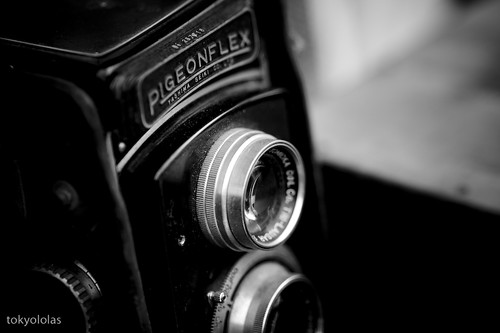Pigeonflex
The Pigeonflex (ピジョンフレックス, pijonfurekkusu) is a TLR for 6×6 exposures on 120 film. The first model was manufactured by Yashima Kōgaku Seiki (later Yashica). Later models were manufactured by Shinano Kōki (信濃光機). All were marketed by Endō Shashin Yōhin.
All models of the Pigeonflex have f/3.5 taking lenses, focused by movement of the entire lensboard.
The original Pigeonflex — NB not the same as the Pigeonflex I — was the first camera to be manufactured by Yashima Kōgaku Seiki, slightly predating the Yashimaflex (both 1953).[1] It has Tomioka Tri-Lausar 80mm lenses. The shutter is NKS (B, 1–200) with self-timer and flash synchronization. It was advertised in Japanese camera magazines dated March 1953 till May 1954. An early advertisement shows a decorative silver plate behind both lenses, and prices the camera at ¥15,000; a later one shows no silver plate and price the camera at ¥14,800 including case.[2]
After Yashima decided to sell cameras under its own name, Endō switched suppliers, choosing Shinano Kōki who had already manufactured the Pigeon 35. The resulting Pigeonflex IA had 80mm Pigeonar lenses (f/3.2 for the view lens), a cut-out in the front of the finder hood for a sports finder, and an accessory shoe on the photographer's left. The top of the (closed) finder has a circular decoration at the centre. It was advertised in Japanese camera magazines dated March–September 1954.
The Pigeonflex I was a cheaper model, with 75mm Pigeonar lenses and no sports finder. Some examples have an S. Luna shutter. It was advertised in Japanese camera magazines dated July–December 1954, for ¥12,500 as compared with ¥15,000 for the IA.[3]
The Pigeonflex IB has 80mm Tri-Lausar lenses: f/3.2 above, f/3.5 below. It was advertised in Japanese camera magazines dated from August 1954 till April 1955. It has a silver plate behind both lenses.
The Pigeonflex IC is the same as the IB but with Pigeonar lenses (again 80mm, f/3.2 and f/3.5). It was only advertised in Japanese camera magazines dated August 1954, and possibly was never sold.
Notes
- ↑ Kyōshū no burando ten, p. 10.
- ↑ Advertisements in Asahi Camera, April and October 1954; both reproduced in Kokusan kamera no rekishi, p. 164. There is no decoration on the top of the (closed) hood.
- ↑ Asahi Camera, July 1954; reproduced in Kokusan kamera no rekishi, p. 165.
Sources / further reading
- Asahi Camera (アサヒカメラ) editorial staff. Shōwa 10–40nen kōkoku ni miru kokusan kamera no rekishi (昭和10–40年広告にみる国産カメラの歴史, Japanese camera history as seen in advertisements, 1935–1965). Tokyo: Asahi Shinbunsha, 1994. ISBN 4-02-330312-7. Items 718–22.
- Nihon no kamera o omoshiroku shita kyōshū no burando ten (日本のカメラを面白くした郷愁のブランド展, Exhibition of nostalgic brands that made Japanese cameras interesting). Tokyo: JCII Camera Museum, 1997. Exhibition catalogue; pp. 10–11 profile seven Yashima/Yashica cameras.
- Watakushi no ni-gan-refu kamera-ten (私の二眼レフカメラ展, Exhibition of twin lens reflex cameras). Tokyo: JCII Camera Museum, 1992. (Exhibition catalogue, no ISBN number.) P. 30.
Links
In English:
In Japanese:
- Pigeonflex, at Pleasure Classic Lenses
- Pigeonflex specifications (archive.org), within Japan Family Camera
- Pigeonflex writeup and sample photos, within Chotto pinboke
- Pigeonflex at Otowa no nigan-refu
- Advertisement for the Pigeonflex dated 1954, reproduced in Shashin-Bako

|
| "Yashima Seiki Co." nameplate image by tokyololas (Image rights) |
